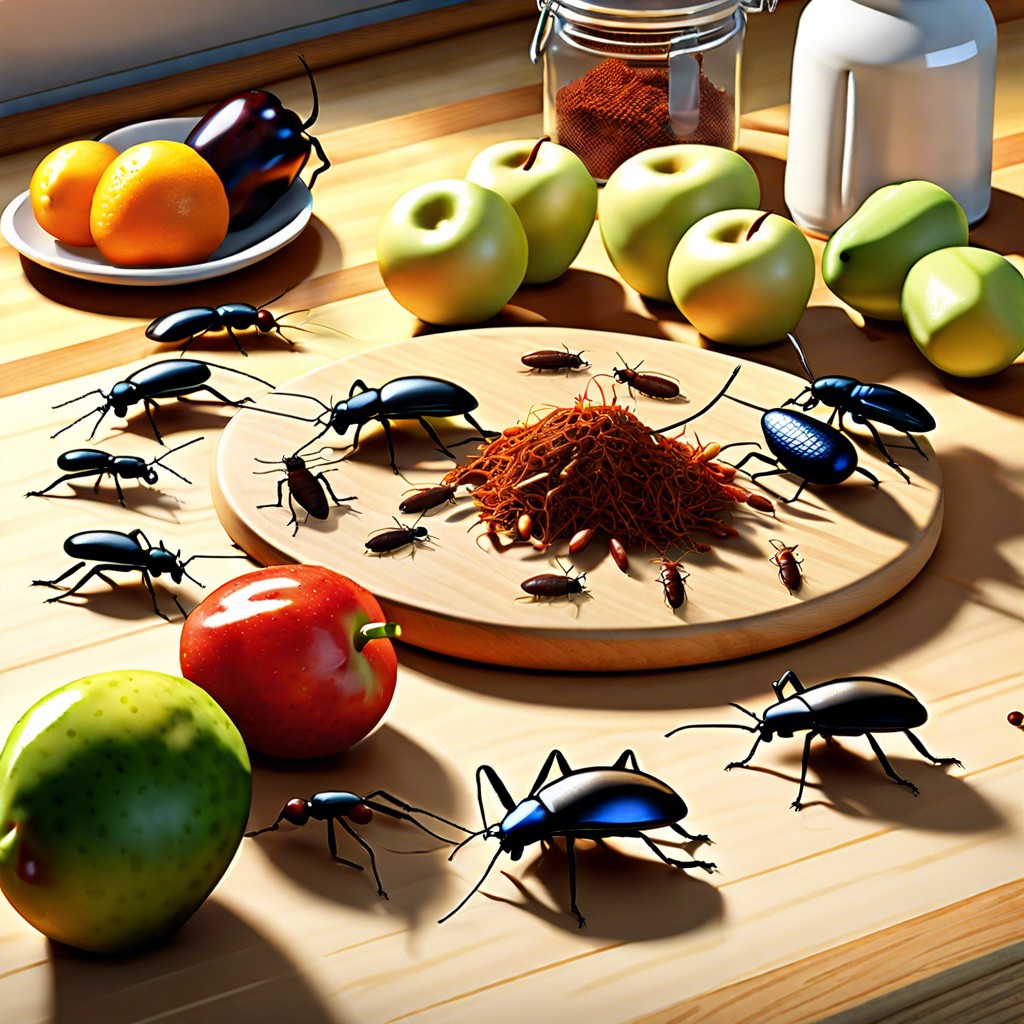Last updated on
Learn how to identify common kitchen bugs and keep your culinary space pest-free.
Feeling like you’re sharing your kitchen with uninvited, tiny roommates? If you’re spotting odd critters or finding mysterious droppings in your pantry, you’re probably in need of some serious pest detective work. From creepy crawlers to stealthy scuttlers, our guide on identifying kitchen bugs and reclaiming your space is your ultimate battle plan. Whether it’s damages, eerie noises, or pesky nests, we’ve got the scoop on tackling them all—and keeping them out for good. Stick around to turn your kitchen back into a critter-free zone!
Key takeaways:
- Identify bug droppings to spot infested areas.
- Look for damaged food packages as bug signs.
- Monitor unusual noises for hidden pests.
- Maintain cleanliness to deter kitchen invaders.
- Call professionals for severe infestations or damage.
What's Inside
Physical Sightings

Catching a bug red-handed is like catching someone sneaking the last cookie from the jar. Here are the tell-tale signs:
You might spot tiny insects scurrying across your countertops, pantry shelves, or even taking a dip in your flour jar. Common offenders include ants, cockroaches, and pantry moths. Each has its own quirks; cockroaches, for instance, love making grand appearances when you least expect them.
Then there are those sneaky web spinners – spiders. Despite their insect control benefits, they’re not typically welcome in your kitchen.
You may also witness some aerial acrobatics by fruit flies hovering near ripe bananas or overripe tomatoes. They seem to love putting on a show.
So, keep an eye out! Your kitchen might turn into a surprise episode of Animal Planet.
Droppings
Alright, now let’s dive into some of the delightful (wink, wink) evidence they leave behind: their droppings. Crumbs, but not the tasty kind!
- Mice and rats: These furry trespassers leave small, pellet-like droppings, often found around food sources or in hidden corners. If your cereal box is starting to resemble a crime scene, it’s time to take action!
- Cockroaches: Their droppings look like coffee grounds or black pepper sprinkled around. Look closely—you might find them in kitchen cabinets, under sinks, or behind appliances. Not exactly the spice of life!
- Pantry insects like moths and beetles: They leave tiny grains of debris or webbing that is not part of your grandma’s old recipe. Check for this unwelcome texture in flour, grains, and cereals.
- Ants: These little explorers leave behind small, almost unnoticeable flecks. Their tiny road markers usually lead to sugary treasures or greasy goodies.
Stay vigilant, my friend. Your kitchen is a battlefield, and the droppings are the enemy’s trail. Time to clean up and reclaim your territory!
Damaged Food Packages
Pesky little critters love a good snack, especially when it’s your favorite pasta. They often chew through food packaging to get to the delicious contents inside. If you spot small holes or tears in boxes, bags, or wrappers, you might have some unwelcome dinner guests.
- Look for:
- Tiny holes in cereal boxes – likely the work of pantry moths.
- Chewed corners of flour bags – weevils enjoy a good baking ingredient as much as you do.
- Torn pasta packaging – probably a treat for silverfish or even mice.
Remember, bugs are like tiny burglars; they don’t clean up after themselves. Damaged food packages lead to crumbs and spills, their personal buffet. Keep an eye out and clean up swiftly to discourage them from setting up camp in your kitchen.
Unusual Noises
If you hear a weird, faint rustling in your kitchen and you don’t own a pet mouse, there’s a good chance you have some unwelcome guests. Certain insects can be quite chatty, and not in a good way.
Cockroaches, for instance, are notorious for making scurrying sounds as they move around. They are fast movers and tend to stick to dark corners, so you’ll often hear them before you see them. Mice are even noisier – their scampering can sound like a tiny stampede across your countertops at night.
Those odd scratching sounds inside your walls or under your floors? Likely to be carpenter ants or termites having themselves a big ol’ house-wrecking party.
Sometimes, you’ll hear buzzing noises. Flying insects like pantry moths and fruit flies love to make their presence known audibly.
So if your kitchen sounds like it’s hosting an insect rager when the lights go out, it’s time to investigate and evict your noisy neighbors. No one wants to share their midnight snack with an uninvited, six-legged percussion section.
Nests and Hiding Places
Those pesky critters have favorite hideouts, just like your cat with the laundry basket. Dark, cozy, and often out-of-sight spots are their prime real estate.
Under sinks, where it’s damp and quiet, you’ll often find cockroaches setting up camp. Behind appliances like your refrigerator or oven – their version of a five-star resort – they thrive away from human eyes.
Unused cupboards? Definitely check those corners. Small bugs like flour beetles and pantry pests make their homes in neglected spaces, often near dry food sources.
Cracks and crevices in walls or around window seals are like secret passageways for insects. Bedbugs and ants are notorious for utilizing these tight spots to stay hidden.
Cardboard boxes and paper bags? Think of these materials as condos for silverfish and roaches. They love munching on the cellulose.
Look out for wasps or spiders crafting nests in ventilated areas like attics or basements. They are the secret architects of the insect world.
Always remember, if you wouldn’t nap there, a bug might!
Immediate Steps
First, breathe! No need to panic, we’ve got this.
Start by isolating the affected area. If you’ve discovered bugs in your pantry, remove all items and inspect them carefully. Seal any suspicious packages in airtight bags or containers.
Cleanliness is your best friend. Sweep, vacuum, and wipe down all surfaces with a strong cleaning solution. Pay close attention to corners and crevices where bugs love to hide.
Dispose of infested items immediately. Double-bag them if possible to prevent any escapees on the way out. Your garbage can might start to feel like a bug nursing home otherwise.
Set up traps or bait stations around hotspots. These can help you catch the culprits while you’re running recon on their little hideouts.
Monitor the situation. Jot down any new sightings or suspicious activities, and make sure to follow up with another round of cleaning in the coming days. Popcorn kernels out in the open will not help your case here.
Sanitization
Firstly, keep your kitchen spotless. Wipe down counters, sweep floors, and clean up spills immediately. Bugs love crumbs and sticky spots, so don’t give them any reason to stick around.
Store food in sealed containers. Spaghetti in a half-open box? Bad idea. Transfer pantry items to airtight jars or plastic bins. No bug can invade your army of jarred grains.
Take out the trash regularly. An overflowing bin is like a five-star buffet for insects. Also, clean the trash can itself. Who knew? Even your garbage holder can get grime build-up that attracts pests.
Don’t forget the drains and sink. Leftover food particles can be a magnet for creepy crawlies. Let’s not turn the sink into a bug Jacuzzi.
Lastly, keep an eye on pet food. Your furry friend’s kibble can be just as appealing to bugs. Try to store pet food in sealed containers too, and clean up bowls after mealtime.
A clean kitchen is an uninviting kitchen—for bugs, that is!
Measures to Prevent Future Pests
First off, regular cleaning is your best friend. Sweep, mop, and wipe down surfaces often. Crumbs and spills make a five-star buffet for pests.
Seal up your food. Use airtight containers for cereals, flours, and grains. Bugs aren’t equipped with tiny crowbars.
Take out the trash promptly. Letting it sit is like sending a gilded invitation to dinner.
Don’t forget about your pet’s food. Store it securely and clean up the feeding area regularly. Bugs love kibble, too.
Fix any leaks. Standing water and moisture are a bug’s dream home. Keep things dry.
Install window screens and keep doors closed when not in use. Bugs aren’t paying rent, so don’t let them in for free.
Sprinkle essential oils like peppermint or lavender around entry points. Bugs don’t like the smell, and your kitchen will smell fabulous.
Check groceries before storing them. Sometimes pests hitch a ride from the grocery store right to your pantry. Don’t give them a free ride.
These simple steps can turn your kitchen from a bug’s paradise into a no-fly zone. Happy cooking!
When to Call a Professional
Sometimes, the little creepy crawlies start to feel like they’re staging a full-scale invasion. That’s when it’s time to bring in the pros. Wondering if it’s that time? Here are a few clues:
If you’ve tried everything short of performing an exorcism and they just won’t leave, calling a professional is the way to go. Your sanity is worth it.
Not every pest is as harmless as it looks. Some can spread diseases or cause significant damage. Professionals know which ones to worry about.
Seeing a bug or two isn’t usually a big deal, but if you’re finding swarms, nests, or consistent droppings, it’s time to call in reinforcements. Pros have the tools and expertise to deal with infestations before they get out of hand.
Home remedies can only go so far. If you’ve used sprays, traps, and every trick in the book but the problem persists, professionals bring industrial-strength solutions that work.
Certain bugs, like termites or carpenter ants, can cause structural damage to your home. If you suspect these, call a professional immediately to prevent costly repairs down the road.
Pest control experts can identify entry points and vulnerabilities you might miss. They’ll help you seal up your fortress better than a medieval castle.
Health Risks
Having unwanted guests in your kitchen can be more than just a nuisance – it can be a health hazard. Bugs can carry bacteria and pathogens that lead to foodborne illnesses. Imagine opening your pantry and finding a cockroach seminar in full swing – yikes!
Roaches, for example, are pros at spreading nasty stuff like E. coli and Salmonella. They take pride in their work.
Flies can also join the vip list. They love to mingle around your food and drink, leaving behind microbes that can trigger food poisoning.
Let’s not forget about rodents. Finding mouse droppings in your flour? Not a good look. Mice and rats host harmful bacteria that can lead to serious illnesses.
Even those tiny ants parading across your countertop can carry germs from the dirtiest places imaginable to your food prep areas.
Feeling itchy yet? Moth larvae can get into your grains and dry goods. Besides being gross, ingesting these pests can lead to gastrointestinal distress. Talk about unwelcome dinner guests!
Keeping a bug-free kitchen isn’t just about peace of mind; it’s about keeping yourself and your loved ones safe and healthy.




